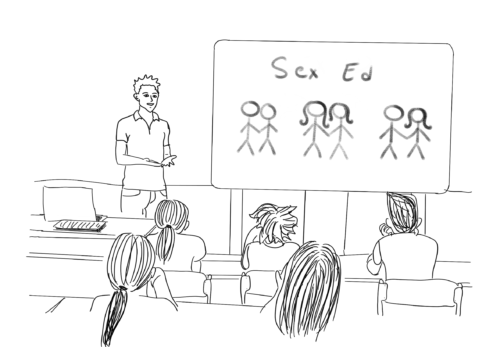The majority (57%) of students in the United States have sex before graduating from high school, according to the Guttmacher Institute. At a time when teenagers are having sex earlier and with more partners than ever before, providing access to medically accurate and nondiscriminatory sex education is crucial to ensuring that adolescents can engage in sex safely.
Around the U.S., students have dramatically different experiences in their sex education classes, which teach adolescents about a range of topics related to sex and sexuality. Eliza Fried ’27 recalls giggling alongside her classmates at the Commonwealth School outside of Boston, Massachusetts, in her ninth-grade “sex ed” class as her teacher passed around condoms, blindfolds, and wooden penises. The teacher instructed the students to blindfold themselves before putting the condoms on the wooden models to simulate the dark environment of a bedroom.
By contrast, Annika Dellinger ’27 never received any sex education at Stonewall Jackson High School in Shenandoah County, Virginia. What she remembers most vividly about her middle school sex education though was a few periods of physical education during which a football coach repeated over and over, “Just don’t have sex.”
Due to the absence of a federal mandate on sex education in the United States, sex education varies greatly across states, school districts, and even individual schools. Thirty-nine states and Washington, D.C., currently require some form of sex or HIV/AIDS education, but that leaves a significant swath of the country without any sex education requirements. Even in the states that do mandate sex education, the timing, instructors, and content of the programs differ markedly, as more states require that their curricula emphasize abstinence than require they be medically accurate.
In some states, like California and Oregon, students must receive some form of age-appropriate sex education every year. In others, they may receive sex education only periodically in middle school and high school—either online or in-person—and may be taught by health teachers, gym coaches, or even outsourced church leaders or pregnancy crisis center representatives. Many students receive no sex education at all, either because their schools do not provide sex education or because their parents have opted for their children not to participate in those classes.
Moreover, there are several different categories of sexual education provided at schools around the country: abstinence-only, abstinence-plus, sexual risk avoidance, and comprehensive sex education. The first three, opposed by prominent medical experts like the American Medical Association, American College of Obstetricians and Gynecologists, and the Society for Adolescent Health and Medicine, emphasize waiting to have sex until marriage to avoid the risks of pregnancy or sexually transmitted infections (STIs). These programs now receive $110 million annually in federal funding, up from $50 million in 2010. Yet research shows the rates of adolescent pregnancies and births are greater in states whose programs emphasize abstinence. Studies also show that these programs do not reduce the frequency of sex or the incidence of HIV and other STIs in teenagers.
More generally, sex education curricula that stress abstinence have contributed to a culture that dramatizes, rather than normalizes, teenage sex. Students are taught to associate sex with fear, guilt, and shame, rather than view sex as a healthy part of life when engaged in safely. In countries with more comprehensive sex education programs, like the Netherlands, attitudes toward adolescent sex have grown more accepting, and teenagers are more likely to engage in relational sex and feel comfortable communicating about sex with their parents and others.
Comprehensive sex education programs are designed to equip students with medically accurate information on how to have sex safely. These programs may also address other related topics such as gender and sexual identity, consent, and healthy relationships. The effectiveness of comprehensive sex education is still up for debate due to a lack of rigorous research comparing the results of different programs. However, there is some evidence suggesting that comprehensive sex education around the world has contributed to later initiation and decreased frequency of sexual intercourse, fewer sexual partners, and increased contraceptive use. Moreover, research suggests that these programs may have the additional benefit of reducing homophobia, increasing understanding of gender and sexuality, and decreasing sexual violence.
The addition of LGBTQ+-inclusive material to sex education curricula has thrown sex education into the fierce culture wars occurring around the country. These culture wars have led to a serious decline in the quality of many sex education programs in public schools, with students less likely to report receiving sex education on topics considered essential by the CDC in 2015-2019 than they were in 1995. Students around the country are now more likely to hear about the virtues of abstinence until marriage and the dangers of adolescent and premarital sex than about where to obtain birth control or how to use a condom.
Harvard students from states where abstinence is the primary focus of sex education programs wished they had received more substantive sex education in high school. Jeeya Patel ’27, who received only a minimal online sex education at her high school in Charleston, West Virginia, said, “With the number of teen pregnancies we had at our school…it wouldn’t have hurt anyone and definitely would have helped some people if [the sex education] had been more thorough and included different types of sex.” Anya Movius ’27 also felt that much was missing from the sex education at her high school in Charlottesville, Virginia: “Consent education, among other things,” was missing. She continued, commenting, “They also don’t talk about being queer in a very nuanced way and what queer sex looks like.”
Although Fried may not have initially appreciated just how comprehensive her sex education was in high school, looking back and hearing about the deficiencies in other programming, she is now grateful for the discussions she was able to have on sexuality, consent, and self-worth in sex. “Honestly,” she said, “[It] was pretty useful to hear.”
Gemma Maltby ’27 (gmaltby@college.harvard.edu) accidentally skipped sex ed in high school.

